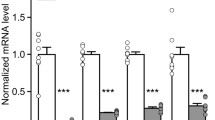Abstract
Reduced β-adrenergic responsiveness in the heart is a characteristic feature of heart failure. G protein-coupled receptor kinase 2 (GRK2) phosphorylates β-adrenoceptors in an agonist-dependent manner, causing receptor uncoupling and desensitisation. Elevated levels of both GRK2 mRNA and activity have been shown to occur in the failing human heart (Ungerer et al. (1992) Circulation 87: 454–463). We have analysed levels of GRK2 protein in heart tissue from the cardiomyopathic Syrian hamster CHF 147 and compared these to GRK2 levels in age-matched, non-cardiomyopathic control hamsters (CHF 148). GRK2 protein levels were found to be significantly increased in the left ventricles of the cardiomyopathic hamsters compared to the controls. The relative amounts of GRK2 in the cardiomyopathic hamsters, as compared to normal controls, increased with age from 2-fold at 100 days to 5-fold at 350 days. These animals should provide a useful model for testing the effect of GRK2 inhibitors on the development of heart failure.
Similar content being viewed by others
Author information
Authors and Affiliations
Additional information
Received: 6 November 2000 / Returned for revision: 2 January 2001 / Revision received: 11 January 2001 / Accepted: 15 January 2001
Rights and permissions
About this article
Cite this article
Harris, C., Chuang, TT. & Scorer, C. Expression of GRK2 is increased in the left ventricles of cardiomyopathic hamsters. Basic Res Cardiol 96, 364–368 (2001). https://doi.org/10.1007/s003950170044
Issue Date:
DOI: https://doi.org/10.1007/s003950170044




